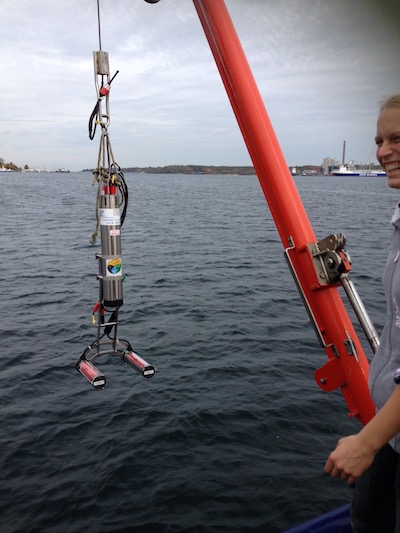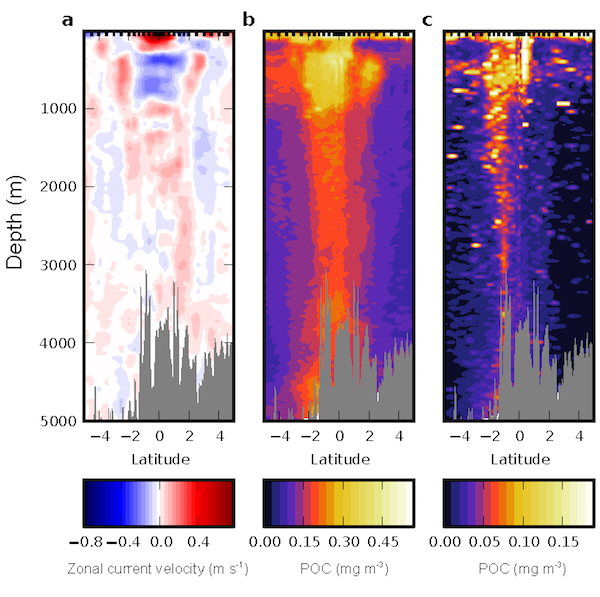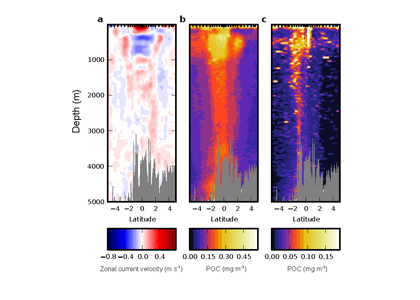The continual flow of organic particles such as dead organisms and fecal material towards the deep sea is called “marine snow,” and it plays an important role in the ocean carbon cycle and climate-related processes. This snowfall is most intense where high primary production can be observed near the surface. This is the case along the equator in the Pacific and Atlantic Oceans. However, it is not well known how particles are distributed at depth and which processes influence this distribution. A recent study published in Nature Geoscience involved the use of high-resolution particle density data using the Underwater Vision Profiler (UVP) from the equatorial Atlantic and Pacific Oceans down to a depth of 5,000 meters, revealing that several previously accepted ideas on the downward flux of particles into the deep sea should be revisited.

Figure 1. The Underwater Vision Profiler (UVP) during a trial in the Kiel Fjord. The UVP provided crucial data for the new study. Photo: Rainer Kiko, GEOMAR
It is typically assumed that the largest particle density can be found close to the surface and that density attenuates continuously with depth. However, high-resolution particle data show that density increases again in the 300-600-meter depth range. The authors attribute this observation to the daily migratory behavior of organisms such as zooplankton that retreat to these depths during the day, contributing to the particle load via defecation and mortality.
Another surprising result is the observation of many small particles below 1,000 meters depth that contribute a large fraction of the bathypelagic particle flux. This observation counters the general assumption, especially in many biogeochemical models, that particle flux at depth comprises fast sinking particles such as fecal pellets. Diminished remineralization rates of small particles or increased disaggregation of larger particles may contribute to the elevated small particle fluxes at this depth.

Figure 2. Zonal current velocity and Particulate Organic Carbon (POC) content across the equatorial Atlantic at 23˚W as observed in November 2012. From left to right: Zonal current velocity, POC content in small particle fraction and POC content in large particle fraction (adapted from Kiko et al. 2017).
This study highlights the importance of coupled biological and physical processes in understanding and quantifying the biological carbon pump. Further work on this important topic can now also be submitted to the new Frontiers in Marine Science research topic “Zooplankton and Nekton: Gatekeepers of the Biological Pump” (https://www.frontiersin.org/research-topics/8114/zooplankton-and-nekton-gatekeepers-of-the-biological-pump; Co-editors R. Kiko, M. Iversen, A. Maas, H. Hauss and D. Bianchi). The research topic welcomes a broad range of contributions, from individual-based process studies, to local and global field observations, to modeling approaches to better characterize the role of zooplankton and nekton for the biological pump.
Authors:
R. Kiko (GEOMAR)
A. Biastoch (GEOMAR)
P. Brandt (GEOMAR, University of Kiel)
S. Cravatte (LEGOS, University of Toulouse)
H. Hauss (GEOMAR)
R. Hummels (GEOMAR)
I. Kriest (GEOMAR)
F. Marin (LEGOS, University of Toulouse)
A. M. P. McDonnell (University of Alaska Fairbanks)
A. Oschlies (GEOMAR)
M. Picheral (Laboratoire d’Océanographie de Villefranche-sur-Mer, Observatoire Océanologique)
F. U. Schwarzkopf (GEOMAR)
A. M. Thurnherr (Lamont-Doherty Earth Observatory,)
L. Stemmann (Sorbonne Universités, Observatoire Océanologique)




